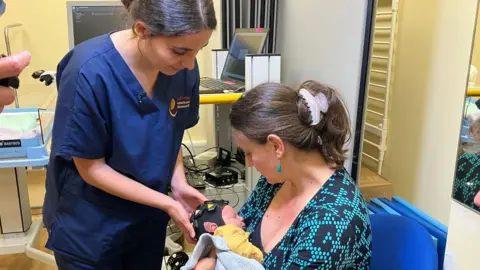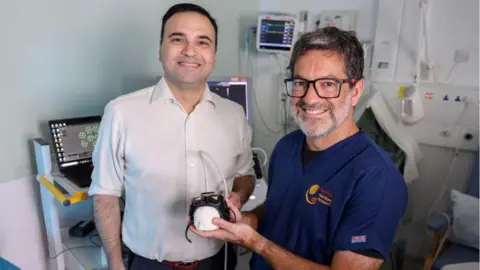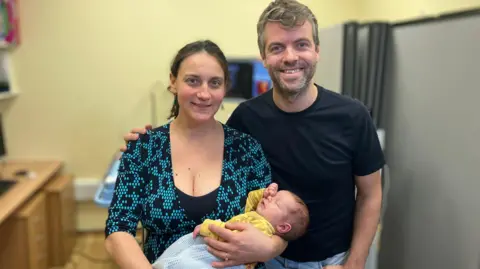Machinine MachinEast of England Technology Ceignology, Cambridge
 BBC
BBCThree weeks old sleeping in a bed, not knowing that he is helping to test new technology that will change the lives of others.
Dr Forera Faure slowly fitted him with a small black cap that looked like a swimming cap, or something to wear in rugby.
It is covered in hexagonal bumps, with technology that monitors how his brain works.
Researchers at Rosie maternity hospital In Cambridge says that they are the first in the world to test a new method that can facilitate the diagnosis and care of children with cerebral and learning difficulties.
It could be used in UK hospitals within the decade.
“This is the first time that light and ultrasound are used like this to provide a more complete picture of the brain,” said Dr Feure, a researcher from the optical arrangement of neonates) study.
In the weeks leading up to the birth following, Our Brains are renewed every day.
Brain damage in newborns is a major cause of lifelong impairment, and a Program to reduce brain damage In childbirth that is now rolled out by the NHS.
Damage can affect the brain’s ability to communicate with the body, leading to conditions such as epilepsywhich causes seizures, or cerebral palsywhich affects movement and coordination.
it more common in earlier births But can cause many issues, including oxygen distribution, haemorrhage, infection or birth trauma.
But for the five out of every 1,000 babies with brain damage, current monitoring methods aim to predict how and to what extent the child will develop as they grow.

Explaining how the CAP works, Dr Faure says: “Light sensors monitor changes in oxygen on the surface under the brain – and the functional ultrasound allows us to drink small blood vessels deep in the brain.”
But the device is also different because it is portable, so it can always control the children, and from the comfort of their bed.
Consultant Neurosurgeon Dr Alexis Joannides believes that it has many advantages over traditional mr (magnetic resonance imaging) or Cus (Cranial ultrasound scans).
“MRI has limitations for two reasons: one is cost and availability of scan slots,” he explained.
“The other is that you have to take the baby to a noisy scanner, wait maybe 20 minutes for the scan and then bring the baby back.
“This means, realistically, you cannot do a series of scans, but in the first weeks, the brain can be regenerated every day with frequent tests.”
MRI and CUS are also considered to have limited ability to predict the nature of any impairment due to the complex relationship between brain structure and function, even Study Led by Imperial College London In 2018 reported that accuracy can be improved with an additional 15-minute scan.

By conducting regular tests on infants, it is hoped that problems will be identified early, and treatments and interventions can begin quickly.
Pure Love Action Cerebral Palsy research is accepted.
“For many children with cerebral palsy, the road to diagnosis is a long one, and families can spend on developmental issues but do not fully understand what it means,” says the meaning that is what this advocate means.
“Technology like this can make all the difference, but it’s important that the capacity of community therapists is mobilized to keep up with demand.”
 The hospitals of Cambridge University NHS Foundation Trust
The hospitals of Cambridge University NHS Foundation TrustProf Topun Austin is a consultant neonatologist and director of the Cambridge Campridge Condlyn Perinatal Imenting Centre. His research focuses on brain treatments across the lifespan – young and old.
He explained: “The fusion study aims to develop and demonstrate a system for the cot-side evaluation of brain activity in newborns in the world.
“We have successfully completed 12 months of proof-of-concept support in healthy and still-born children and will now focus on children considered to be at higher risk of brain damage.
“Understanding the patterns of brain patterns in both term and preter children will help us identify those most vulnerable to damage at an early stage.”

Theo was one of the healthy term babies who took part in the trial, but his mother, Stani Georgieva, felt it was important to contribute.
“His father and I are both scientists and when TOO is growing up he can take advantage of all the advances made through research, so we are the reason that he is a small part of the understanding,” he said.
Dr Joannides is also a director of The HihR Healthtech Research Center on brain injurywhich is based in Cambridge. It exists to help develop new technologies to improve the lives of people with brain injuries.
The center has funded a researcher for the study and will lend its expertise to help roll out the device across the NHS, if the study proves successful.
“We have hurdles to overcome, but we hope, within three to five years we will have a product that can be evaluated more widely,” he said.
“Tolerating the cost, not only controls children with known problems, but also a screening tool to help others who may be at risk.”


